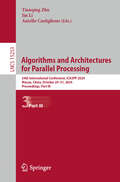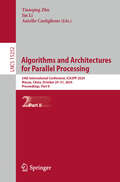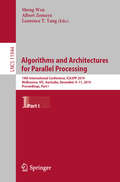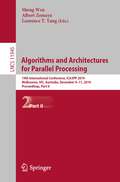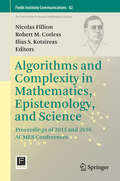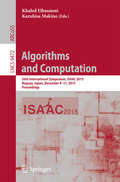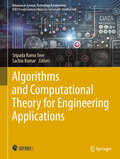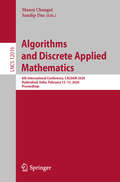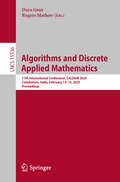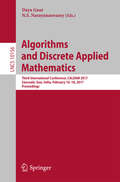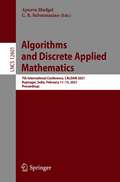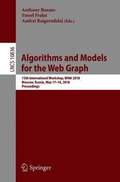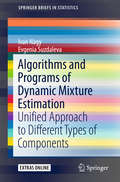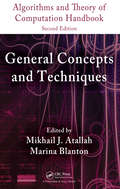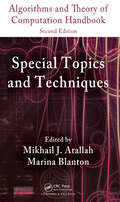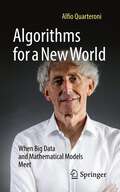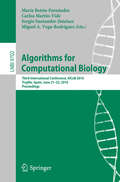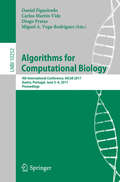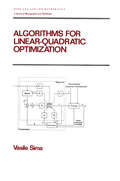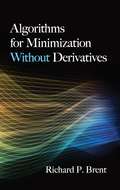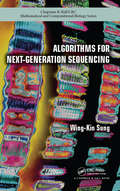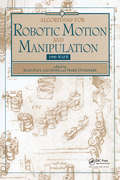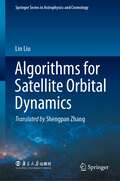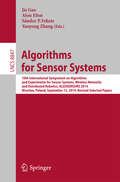- Table View
- List View
Algorithms and Architectures for Parallel Processing: 24th International Conference, ICA3PP 2024, Macau, China, October 29–31, 2024, Proceedings, Part III (Lecture Notes in Computer Science #15253)
by Tianqing Zhu Jin Li Aniello CastiglioneThe six-volume set, LNCS 15251-15256, constitutes the refereed proceedings of the 24th International Conference on Algorithms and Architectures for Parallel Processing, ICA3PP 2024, held in Macau, China, during October 29–31, 2024. The 91 full papers, 35 short papers and 5 workshop papers included in these proceedings were carefully reviewed and selected from 265 submissions. They focus on the many dimensions of parallel algorithms and architectures, encompassing fundamental theoretical approaches, practical experimental projects, and commercial components and systems.
Algorithms and Architectures for Parallel Processing: 24th International Conference, ICA3PP 2024, Macau, China, October 29–31, 2024, Proceedings, Part II (Lecture Notes in Computer Science #15252)
by Tianqing Zhu Jin Li Aniello CastiglioneThe six-volume set, LNCS 15251-15256, constitutes the refereed proceedings of the 24th International Conference on Algorithms and Architectures for Parallel Processing, ICA3PP 2024, held in Macau, China, during October 29–31, 2024. The 91 full papers, 35 short papers and 5 workshop papers included in these proceedings were carefully reviewed and selected from 265 submissions. They focus on the many dimensions of parallel algorithms and architectures, encompassing fundamental theoretical approaches, practical experimental projects, and commercial components and systems.
Algorithms and Architectures for Parallel Processing: 19th International Conference, ICA3PP 2019, Melbourne, VIC, Australia, December 9–11, 2019, Proceedings, Part I (Lecture Notes in Computer Science #11944)
by Albert Zomaya Laurence T. Yang Sheng WenThe two-volume set LNCS 11944-11945 constitutes the proceedings of the 19th International Conference on Algorithms and Architectures for Parallel Processing, ICA3PP 2019, held in Melbourne, Australia, in December 2019. The 73 full and 29 short papers presented were carefully reviewed and selected from 251 submissions. The papers are organized in topical sections on: Parallel and Distributed Architectures, Software Systems and Programming Models, Distributed and Parallel and Network-based Computing, Big Data and its Applications, Distributed and Parallel Algorithms, Applications of Distributed and Parallel Computing, Service Dependability and Security, IoT and CPS Computing, Performance Modelling and Evaluation.
Algorithms and Architectures for Parallel Processing: 19th International Conference, ICA3PP 2019, Melbourne, VIC, Australia, December 9–11, 2019, Proceedings, Part II (Lecture Notes in Computer Science #11945)
by Albert Zomaya Laurence T. Yang Sheng WenThe two-volume set LNCS 11944-11945 constitutes the proceedings of the 19th International Conference on Algorithms and Architectures for Parallel Processing, ICA3PP 2019, held in Melbourne, Australia, in December 2019. The 73 full and 29 short papers presented were carefully reviewed and selected from 251 submissions. The papers are organized in topical sections on: Parallel and Distributed Architectures, Software Systems and Programming Models, Distributed and Parallel and Network-based Computing, Big Data and its Applications, Distributed and Parallel Algorithms, Applications of Distributed and Parallel Computing, Service Dependability and Security, IoT and CPS Computing, Performance Modelling and Evaluation.
Algorithms and Complexity in Mathematics, Epistemology, and Science: Proceedings of 2015 and 2016 ACMES Conferences (Fields Institute Communications #82)
by Nicolas Fillion Robert M. Corless Ilias S. KotsireasACMES (Algorithms and Complexity in Mathematics, Epistemology, and Science) is a multidisciplinary conference series that focuses on epistemological and mathematical issues relating to computation in modern science. This volume includes a selection of papers presented at the 2015 and 2016 conferences held at Western University that provide an interdisciplinary outlook on modern applied mathematics that draws from theory and practice, and situates it in proper context. These papers come from leading mathematicians, computational scientists, and philosophers of science, and cover a broad collection of mathematical and philosophical topics, including numerical analysis and its underlying philosophy, computer algebra, reliability and uncertainty quantification, computation and complexity theory, combinatorics, error analysis, perturbation theory, experimental mathematics, scientific epistemology, and foundations of mathematics. By bringing together contributions from researchers who approach the mathematical sciences from different perspectives, the volume will further readers' understanding of the multifaceted role of mathematics in modern science, informed by the state of the art in mathematics, scientific computing, and current modeling techniques.
Algorithms and Computation: 26th International Symposium, ISAAC 2015, Nagoya, Japan, December 9-11, 2015, Proceedings (Lecture Notes in Computer Science #9472)
by Khaled Elbassioni Kazuhisa MakinoThis book constitutes the refereed proceedings of the 26th InternationalSymposium on Algorithms and Computation, ISAAC 2015, held in Nagoya, Japan, inDecember 2015. The 65 revised full papers presented together with 3 invited talks were carefullyreviewed and selected from 180 submissions for inclusion in the book. The focusof the volume is on the following topics: computational geometry; datastructures; combinatorial optimization and approximation algorithms; randomizedalgorithms; graph algorithms and FPT; computational complexity; graph drawingand planar graphs; online and streaming algorithms; and string and DNAalgorithms.
Algorithms and Computational Theory for Engineering Applications (Advances in Science, Technology & Innovation)
by Sripada Rama Sree Sachin KumarThis book goes deeply into the world of algorithms and computational theory and its astounding influence on numerous engineering areas. The book's carefully chosen content highlights the most recent studies, approaches, and real-world applications that are revolutionising engineering. The book is structured into distinct sections, each of which examines an important topic in computational theory and algorithms. The authors propose cutting-edge optimisation methods that revolutionise the way engineers approach engineering problems by allowing them to solve complicated issues quickly and effectively. The book illustrates the techniques and equipment used in the fields of data science and big data analytics to glean insightful information from enormous databases. Data visualisation, predictive modelling, clustering, and anomaly detection are a few examples of how algorithms are used to find patterns and trends that help engineers make well-informed decisions. Before being physically implemented, complex systems are built, tested, and optimised in the virtual environment thanks to computational modelling and simulation. The book examines numerical techniques, finite element analysis, computational fluid dynamics, and other simulation techniques to highlight how algorithms are changing engineering system design and performance optimisation. The book also delves into the intriguing field of robotics and control systems. The book's readers will learn about the algorithms that advance sensor fusion, intelligent control, path planning, and real-time systems, paving the way for innovations in autonomous driving, industrial automation, and smart cities. Readers will learn more about how algorithms and computational theory are modifying engineering environments, opening up new opportunities, and changing industries by examining the book's chapters. This book is a must-have for anyone looking to keep on top of the intersection of algorithms, computational theory, and engineering applications because of its concentration on practical applications and theoretical breakthroughs.
Algorithms and Discrete Applied Mathematics: 6th International Conference, CALDAM 2020, Hyderabad, India, February 13–15, 2020, Proceedings (Lecture Notes in Computer Science #12016)
by Manoj Changat Sandip DasThis book constitutes the proceedings of the 6th International Conference on Algorithms and Discrete Applied Mathematics, CALDAM 2020, held in Hyderabad, India, in February 2020. The 38 papers presented together with 2 invited talks in this volume were carefully reviewed and selected from 102 submissions. The papers are organized in topical sections on graph algorithms, graph theory, combinatorial optimization, distributed algorithms, combinatorial algorithms, and computational complexity.
Algorithms and Discrete Applied Mathematics: 11th International Conference, CALDAM 2025, Coimbatore, India, February 13–15, 2025, Proceedings (Lecture Notes in Computer Science #15536)
by Daya Gaur Rogers MathewThis book constitutes the refereed proceedings of the 11th International Conference on Algorithms and Discrete Applied Mathematics, CALDAM 2025, held in Coimbatore, India, during February 13–15, 2025. The 30 full papers included in this book were carefully reviewed and selected from 89 submissions.The conference had papers in algorithms and complexity, discrete applied mathematics, computational geometry, graph theory, graph colouring, graph partition, and domination in graphs.
Algorithms and Discrete Applied Mathematics: Third International Conference, CALDAM 2017, Sancoale, Goa, India, February 16-18, 2017, Proceedings (Lecture Notes in Computer Science #10156)
by Daya Gaur N. S. NarayanaswamyThis book constitutes the proceedings of the Third International Conference on Algorithms and Discrete Applied Mathematics, CALDAM 2017, held in Goa, India, in February 2017. The 32 papers presented in this volume were carefully reviewed and selected from 103 submissions. They deal with the following areas: algorithms, graph theory, codes, polyhedral combinatorics, computational geometry, and discrete geometry.
Algorithms and Discrete Applied Mathematics: 7th International Conference, CALDAM 2021, Rupnagar, India, February 11–13, 2021, Proceedings (Lecture Notes in Computer Science #12601)
by Apurva Mudgal C. R. SubramanianThis book constitutes the proceedings of the 7th International Conference on Algorithms and Discrete Applied Mathematics, CALDAM 2021, which was held in Rupnagar, India, during February 11-13, 2021. The 39 papers presented in this volume were carefully reviewed and selected from 82 submissions. The papers were organized in topical sections named: approximation algorithms; parameterized algorithms; computational geometry; graph theory; combinatorics and algorithms; graph algorithms; and computational complexity.
Algorithms and Models for the Web Graph: 15th International Workshop, WAW 2018, Moscow, Russia, May 17-18, 2018, Proceedings (Theoretical Computer Science and General Issues #10836)
by Anthony Bonato Paweł Prałat Andrei RaigorodskiiThis book constitutes the proceedings of the 15th International Workshop on Algorithms and Models for the Web Graph, WAW 2018, held in Moscow, Russia in May 2018.<P><P> The 11 full papers presented in this volume were carefully reviewed and selected from various submissions. The papers focus on topics like the information retrieval and data mining on the Web; Web as a text repository and as a graph, induced in various ways by link among pages, hosts and users; the understanding of graphs that arise from the Web and various user activities on the Web; stimulation of the development of high-performance algorithms and applications that exploit these graphs.
Algorithms and Programs of Dynamic Mixture Estimation: Unified Approach to Different Types of Components (SpringerBriefs in Statistics)
by Ivan Nagy Evgenia SuzdalevaThis book provides a general theoretical background for constructing the recursive Bayesian estimation algorithms for mixture models. It collects the recursive algorithms for estimating dynamic mixtures of various distributions and brings them in the unified form, providing a scheme for constructing the estimation algorithm for a mixture of components modeled by distributions with reproducible statistics. It offers the recursive estimation of dynamic mixtures, which are free of iterative processes and close to analytical solutions as much as possible. In addition, these methods can be used online and simultaneously perform learning, which improves their efficiency during estimation. The book includes detailed program codes for solving the presented theoretical tasks. Codes are implemented in the open source platform for engineering computations. The program codes given serve to illustrate the theory and demonstrate the work of the included algorithms.
Algorithms and Theory of Computation Handbook, Volume 1: General Concepts and Techniques (Chapman & Hall/CRC Applied Algorithms and Data Structures series)
by Mikhail J. Atallah Marina BlantonAlgorithms and Theory of Computation Handbook, Second Edition: General Concepts and Techniques provides an up-to-date compendium of fundamental computer science topics and techniques. It also illustrates how the topics and techniques come together to deliver efficient solutions to important practical problems. Along with updating and revising many
Algorithms and Theory of Computation Handbook, Volume 2: Special Topics and Techniques (Chapman & Hall/CRC Applied Algorithms and Data Structures series)
by Mikhail J. Atallah Marina BlantonAlgorithms and Theory of Computation Handbook, Second Edition: Special Topics and Techniques provides an up-to-date compendium of fundamental computer science topics and techniques. It also illustrates how the topics and techniques come together to deliver efficient solutions to important practical problems.Along with updating and revising many of
Algorithms for a New World: When Big Data and Mathematical Models Meet
by Alfio QuarteroniCovid-19 has shown us the importance of mathematical and statistical models to interpret reality, provide forecasts, and explore future scenarios. Algorithms, artificial neural networks, and machine learning help us discover the opportunities and pitfalls of a world governed by mathematics and artificial intelligence.
Algorithms for Computational Biology: Third International Conference, AlCoB 2016, Trujillo, Spain, June 21-22, 2016, Proceedings (Lecture Notes in Computer Science #9702)
by María Botón-Fernández Carlos Martín-Vide Sergio Santander-Jiménez Miguel A. Vega-RodríguezThis book constitutes the proceedings of the Third InternationalConference on Algorithms for Computational Biology, AlCoB 2016, held inTrujillo, Spain, in June 2016.The 13 full papers presented in this volume were carefully reviewed andselected from 23 submissions. They are organized in the following topical sections: biological networks and modelling; biological structure processing; phylogenetics; and sequence analysis and rearrangement. In addition one invited talk is included.
Algorithms for Computational Biology: 4th International Conference, AlCoB 2017, Aveiro, Portugal, June 5-6, 2017, Proceedings (Lecture Notes in Computer Science #10252)
by Daniel Figueiredo, Carlos Martín-Vide, Diogo Pratas and Miguel A. Vega-RodríguezThis book constitutes the proceedings of the 4th InternationalConference on Algorithms for Computational Biology, AlCoB 2017, held in Aveiro, Portugal, in June 2017. The 10 full papers presented together with 2 invited papers were carefully reviewed and selected from 24 submissions. They are organized in the following topical sections: Graph Algorithms for Computational Biology; Phylogenetics; and Sequence Analysis and Other Biological Processes.
Algorithms for Computational Biology: 8th International Conference, AlCoB 2021, Missoula, MT, USA, June 7–11, 2021, Proceedings (Lecture Notes in Computer Science #12715)
by Carlos Martín-Vide Miguel A. Vega-Rodríguez Travis WheelerThis book constitutes the proceedings of the 8th International Conference on Algorithms for Computational Biology, AlCoB 2020, was planned to be held in Missoula, MT, USA in June 2021. Due to the Covid-19 pandemic, AlCoB 2020 and AlCoB 2021 were merged and held on these dates together. AlCoB 2020 proceedings were published as LNBI 12099. The 12 full papers included in this volume were carefully reviewed and selected from 22 submissions. They were organized in topical sections on genomics, phylogenetics, and RNA-Seq and other biological processes. The scope of AlCoB includes topics of either theoretical or applied interest, namely: sequence analysis; sequence alignment; sequence assembly; genome rearrangement; regulatory motif finding; phylogeny reconstruction; phylogeny comparison; structure prediction; compressive genomics; proteomics: molecular pathways, interaction networks, mass spectrometry analysis; transcriptomics: splicing variants, isoform inference and quantification, differential analysis; next-generation sequencing: population genomics, metagenomics, metatranscriptomics, epigenomics; genome CD architecture; microbiome analysis; cancer computational biology; and systems biology.
Algorithms for Linear-Quadratic Optimization (Chapman And Hall/crc Pure And Applied Mathematics Ser. #200)
by Vasile SimaThis textbook offers theoretical, algorithmic and computational guidelines for solving the most frequently encountered linear-quadratic optimization problems. It provides an overview of recent advances in control and systems theory, numerical line algebra, numerical optimization, scientific computations and software engineering.
Algorithms for Minimization Without Derivatives (Dover Books on Mathematics)
by Richard P. BrentThis outstanding text for graduate students and researchers proposes improvements to existing algorithms, extends their related mathematical theories, and offers details on new algorithms for approximating local and global minima. None of the algorithms requires an evaluation of derivatives; all depend entirely on sequential function evaluation, a highly practical scenario in the frequent event of difficult-to-evaluate derivatives.Topics include the use of successive interpolation for finding simple zeros of a function and its derivatives; an algorithm with guaranteed convergence for finding a minimum of a function of one variation; global minimization given an upper bound on the second derivative; and a new algorithm for minimizing a function of several variables without calculating derivatives. Many numerical examples augment the text, along with a complete analysis of rate of convergence for most algorithms and error bounds that allow for the effect of rounding errors.
Algorithms for Next-Generation Sequencing (Chapman & Hall/CRC Computational Biology Series)
by Wing-Kin SungAdvances in sequencing technology have allowed scientists to study the human genome in greater depth and on a larger scale than ever before – as many as hundreds of millions of short reads in the course of a few days. But what are the best ways to deal with this flood of data? Algorithms for Next-Generation Sequencing is an invaluable tool for students and researchers in bioinformatics and computational biology, biologists seeking to process and manage the data generated by next-generation sequencing, and as a textbook or a self-study resource. In addition to offering an in-depth description of the algorithms for processing sequencing data, it also presents useful case studies describing the applications of this technology.
Algorithms for Robotic Motion and Manipulation: WAFR 1996
by Jean-Paul Laumond Mark OvermarsThis volume deals with core problems in robotics, like motion planning, sensor-based planning, manipulation, and assembly planning. It also discusses the application of robotics algorithms in other domains, such as molecular modeling, computer graphics, and image analysis. Topics Include: - Planning - Sensor Based Motion Planning - Control and Moti
Algorithms for Satellite Orbital Dynamics (Springer Series in Astrophysics and Cosmology)
by Lin LiuThis book highlights the fundamental physics of orbit theory, dynamical models, methods of orbit determination, design, measurement, adjustment, and complete calculations for the position, tracking, and prediction of satellites and deep spacecraft. It emphasizes specific methods, related mathematical calculations, and worked examples and exercises. Therefore, technicians and engineers in the aerospace industry can directly apply them to their practical work. Dedicated to undergraduate students and graduate students, researchers, and professionals in astronomy, physics, space science, and related aerospace industries, the book is an integrated work based on the accumulated knowledge in satellite orbit dynamics and the author’s more than five decades of personal research and teaching experience in astronomy and aerospace dynamics.
Algorithms for Sensor Systems: 10th International Symposium on Algorithms and Experiments for Sensor Systems, Wireless Networks and Distributed Robotics, ALGOSENSORS 2014, Wroclaw, Poland, September 12, 2014, Revised Selected Papers (Lecture Notes in Computer Science #8847)
by Jie Gao Alon Efrat Sándor P. Fekete Yanyong ZhangThis book constitutes thoroughly refereed and revised selected papers from the 10th International Symposium on Algorithms and Experiments for Sensor Systems, Wireless Networks and Distributed Robotics, ALGOSENSORS 2014, held in Wroclaw, Poland, on September 12, 2014. The 10 papers presented in this volume were carefully reviewed and selected from 20 submissions. They are organized in topical sections named: robot planning; algorithms and data structures on graphs; and wireless networks.
